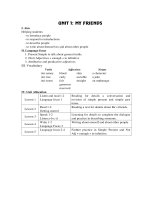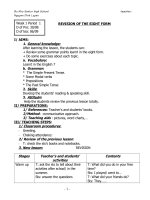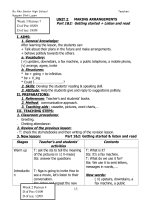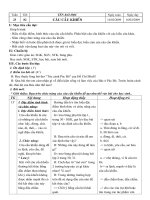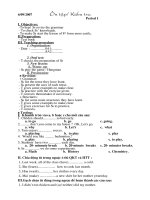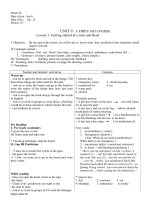giao an anh 8 1 cot 2008-2009
Bạn đang xem bản rút gọn của tài liệu. Xem và tải ngay bản đầy đủ của tài liệu tại đây (1.91 MB, 216 trang )
Date of preparation : September 1
st
,2007.
Unit one : MY FRIENDS
Period 2 : Getting Started + Listen and Read
A. Aims : - Get Ss listen and read the dialogue.
- Help Ss to understand the dialogue about introducing and describing
people.
B.Objective: By the end of the lesson, Ss will be able to introduce people, respond to
introductions and describe people .
C. Preparation: Pictures, posters, stereo, tape.
D. Procedure :
I. Check- up : Check Ss’ preparation.
II. New lesson :
1.Getting started:
* Questions:
+ Do you have a good holiday?
+ What do you often do during your holiday?
+ Do you play games?
+ What games do you like to play?
- Ss answer the questions in individuals.
* T hangs four pictures ( in the text book) on the board
- T asks Ss some questions:
. Picture a : + What are the children doing?
+Where are they?
- Ss answer the questions in individuals.
. Picture b,c,d. Ss work in pairs: one asks and one answers.
- Feedback
2. Listen and read :
a. New words :
+ (to) receive: nhận (example)
Ex: I sent Lan a letter last week, She received it yesterday.
+(a ) next-door neighbor: (explanation)
+(a) photograph : (visual)
b. Practice: ( books shut)
Activity 1:
-T hangs the picture of Hoa and Nien on the board and introduces:
"This is Hoa , this is Nien , Hoa's friend. Hoa is telling Lan about Nien and her letter.
Now let's guess which sentences are true.
- T hangs the poster on the board:
* Choose the correct information:
1> a>. Hoa received Nien's letter yesterday.
b>. Nien received Hoa's letter yesterday.
2> a>. Nien lived next to Hoa' s house in Hue.
b>. Nien lived next to Hoa' s house now .
3> a>. Nien is beautiful.
b>. Nien is not beautiful.
4> a>. Nien is as old as Hoa.
b>. Hoa is older than Nien.
5> a>. Hoa is twelve years old.
b>. Nien is twelve years old.
- Ss work in individuals then compare with a partner.
- Feedback
Activity 2 :
* Books shut
- Ss listen to the tape and check their prediction.
- Ss compare with their partners.
- Ss listen to the tape again to correct their answers.
* Feedback
Answer key: 1a, 2a, 3a , 4b, 5b
* Books open
- Ss listen and repeat after the tape.
- Pair work: Practice acting out the dialogue
* Comprehension questions: ( Exercise 2)
- Ss work in pairs.
* Feedback.
Activity 3 :
- T asks Ss to write a short paragraph about Nien (her age, where she lives, her
appearance,...)
- Ss work in groups of four.
- T calls the representatives to write their writing on the board.
* Feedback
- T corrects.
III. Home work:
- Write the answers for the questions in exercise 2 in your notebooks.
- Do exercise 1 page 5 in workbooks.
IV. Remark:
Date of preparation : September 3
rd
, 2007
Period 1 :
A. Aims :
- To help Ss grasp at the lesson
- To help Ss learning English easily.
B. reparation : books , notebooks.
C. Procedure :
I. The method :
1. At school :
- Listen to the teacher carefully
- Ask the teacher if you don't know anything.
- Do actively what the teacher ask ss to do.
- Be ready to speak to your partners.
- Be helpful to your partners.
- Don't make too much noise while you are playing games.
- Write the lesson fully.
2. At home:
- Learn the lesson combine the books and notebooks.
- Learning the vocabulary: Write the vocab until you learn them by heart.
- Listen to the stereo and practise speaking correctly.
- Apply your knowledge into real situation.
- Do more exercises if you can.
- Practise translating your lesson into Vietnamese.
- Keep writing vocab into your vocab records.
- Do homework carefully and fully.
- Rewrite what you learned in your notebooks.
- Consult many books and other materials
- Organize to learn in groups, pairs or have exchanges with classmates.
II. Homework:
- Prepare for Unit 1.
C Date of preparation : September 5
th
, 2007.
Unit one : MY FRIENDS
Period 3 : Speak + Listen
A. Aims : To practise: +Using adjectives to describe people.
+ Listening and understanding the dialogue
B.Objective: By the end of the lesson , ss will be able to:
+ Describe people.
+ Introduce and greet one another in a conversation.
C. Preparation: Pictures , posters, flashcards
D. Procedure :
I. Check- up :
+ Read and write new words.
+ Answer some questions:
II. Warm up:
Brainstorming:
Nice to meet you
III. New lesson :
1. Speak:
a. Presentation:
* Pre-teach vocab:
+ Slim ( adj) : (realia)
+ Straight (adj) : (visual)
+ Curly (adj) : (visual)
+ bald (adj) : (visual)
+ blond ~ fair (adj) : (visual)
- T models, ss repeat : chorus- individuals
* Checking vocab: R.O.R.
* Set the scene:
-T gives a picture of Mary. Ss look at the picture and fill in the missing words.
Good morning
Greetings
* Open dialogue: ( poster)
Hoa: This person is........................ and.........................
She has a....................... ................................ hair.
Lan: Is this Mary?
Hoa : Yes.
- Ss work in pairs.
Feedback.
b. Practise:
- T elicits the model sentences from ss
This person is short and thin.
She has long blond hair.
* Repetition drill.
* Substitution drill. T gives some cues:
• short / tall / thin / fat.
• short / dark / straight / fair / curly.
*Picture drill:
( Ss play a guessing game)
- T hangs the pictures on the board. Ss describe the people in the picture.
- T models first.
- Ss work in pairs: open pairs- closed pairs.
- T calls some closed pairs.
2. Listen:
a. Pre-listening :
* Pre-teach vocab:
+(a) principal: ( question: Who's Mr Son?).
+ pleasure(n) : (example: It's a pleasure to meet you).
- T models, ss repeat : chorus- individuals
* Checking vocab: R.O.R.
* Open prediction:
- T hangs the picture ( a box of given expressions).
- T asks ss to read the dialogue and number on the expression on the poster.
- Ss work in individuals then compare with a partner.
- Feedback.
b. While listening :
- Ss listen to the tape and check their prediction.
- Feedback1.
- Ss listen to the tape again and correct their answer.
- Feedback 2. – Teacher corrects
c. Post-listening :
- Ss practise introducing and greeting one another.
- Ss work in groups of 3.
IV. Home work :
+ Describe one of your closed friends or the person you like best.
+ Make a dialogue: introduce your friend to your mother.
Date of preparation : September 6
th
,2007.
Unit one : MY FRIENDS
Period 4 : Read
A. Aims : - To help ss to understand the text.
-To use adj to describe one's character and her (his) favorite
activities
B. Objective : By the end of the lesson, ss will be able to talk about their friends'
characters
C. Preparation: posters.
D. Procedure:
I. Check- up :
- Describe one of your closed friends.
- Tell the T some greetings.
II. Warm up:
*Pre- question:
+ Do you have many friends?
+ How many closed friends do you have?
+ What are they like?
+ What do they like?
+ Do they all have the same favorite activities/ characters?
- T asks 2-3 ss.
III. New lesson :
1. Pre-teach vocab :
+ (a) character: (explanation)
+ sociable (adj): (translation)
+ reserved (adj): (translation)
+ generous(adj): (translation)
+ out going (adj): (translation)
+ volunteer (adj) (explanation)
* Checking vocabulary: What and Where
2. Pre-reading: ( books shut)
-T hangs the picture on the board and introduces:
" Ba's at school now.He's talking about his close friends : Khai, Song, Bao .Look at
the statements and decide if they are true or false.
- T hangs the poster on the board:
True/ false statements:
1. Ba likes Khai and Song.
2. Each of them has a different character.
3. Bao is the best soccer player.
4. He often spend his free time doing volunteer work.
5. He studies badly.
6. Song likes reading books.
- Ss guess in individuals.
- Feedback: in two teams.
3. While- reading:
- T has ss read the text silently and check their prediction.
- Feedback.
- Answer key: 1.T, 2T, 3F, 4T, 5F, 6F, 7T.
* Multiple choice:
- T asks ss to read the text again and do the exercise 1 in the text book.
- Ss work in pairs .
- Feedback.
- Answer key : a.A, b.C, c.B, d.D.
* Comprehension questions:
-T ask ss to answer the questions in the book.
- Ss work in pairs : open pairs- closed pairs.
- T calls some closed pairs.
4. Post reading:
*Discussion:
Question: 1. Why is Ba lucky?.
2. Why does Bao always get good grades?
3.Why does Khai like reading?
4. Why are they close friends although they have different characters?
-Ss work in groups of four.
-Feedback.
III. Home work:
-Write a short paragraph ( 50 words) to talk about your close friends
IV. Remark:
C Date of preparation : September 7
th
,2007.
Unit one : MY FRIENDS
Period 5: Write
A. Aims: - To help ss know how to write a short paragraph talking about a friend.
B. Objective: By the end of the lesson, ss will be able to describe or introduce other
people.
C. Preparation: posters.
D. Procedure:
I. Check- up:
-Read and write vocab.
- Answer T's questions.
II. Warm up:
Network
T asks ss to write as many adjectives (using to describe people's characters) as
possible.
helpful
-Ss work in two teams
III. New lesson :
1. Pre-writing:
* Listening(Books shut)
-T hangs the poster on the board:
His name's ........................... and he's .......................years old. He lives
at .................... in Ha Noi with his....................., Hung.
He's ......................., ............................... and helpful. His best friends are ..............,
and....................
-T asks ss to listen and fill in the blanks.
Character
friendly
- Ss work in individuals then compare with a partner.
- Feedback.
* Reading (books open)
- T asks ss to read the paragraph and check their answers.
- T asks ss to look at the box and make questions.
- Ss work in pairs .
- Feedback.
2. While writing :
* Questions and answers:
- T asks ss to ask and answer the questions in E2 then fill the information in the
box.
- Ss work in groups of four.
- T asks some ss to go to the board and fill in the form.
* Write it up:
-T asks ss to write a short paragraph. Using the information in the form.
- Ss work in groups of four (write on the poster).
3. Post-writing:
* Sharing and comparing:
- Ss share with other groups.
* Exhibition:
- T chooses the best paragraphs to stick on the board.
* Correction:
-T corrects the mistakes and asks ss to write down.
IV. Home work:
-Write a paragraph about yourself.
V. Remark:
Name :
Appearance :
Character :
Address :
Family :
Friends :
Date of preparation : September 8
th
,2007.
Unit one : MY FRIENDS
Period 6: Language Focus
A. Aims : - To teach grammar points.
+ Simple past tense.
+Simple present tense.
+ (not) adj + enough + to-infi
B.Objective: By the end of the lesson , ss will be able to use the simple present tense
to talk about general truths and use the structure " (not)adj + enough + to-infi to talk
about someone who has or doesn't have an ability to do something.
C. Preparation: Pictures for B3, posters for B1,2, cards.
D. Procedure :
I. Check- up : Say about yourself.
II. Warm up :
Pelmanism: T uses 10 cards for this game.
1> 2> 3> 4> 5>
6> 6> 7> 8>> 9> 10>
III. New lesson :
1. Exercise 1 :
- T: What are you going to do in exercise 1?
- Ss: Choose the correct form of the verbs in the brackets.
- T asks ss to do the exercise in individuals then compare with their partners.
- Feedback.
- T: + What tense is used in the exercise?
+ Who can tell me the form and the use of this tense?
BE SHOW COME SEND INTRODUCE
SENT WAS/WERE
SHOWN CAME INTRODUCE
- Ss answer the questions in individuals.
- T Writes the form and the use.
* Form:
* Usage: Express an action happening and ending in the past.
- Ss copy down.
2. Exercise 2:
a. Pre-teach vocab:
+ (to) rise: # (to) set.
Ex: The sun rises in the East and sets in the West.
+ (to) move: (mine)
+ (the) earth: (explanation)
+ Mars (n): (translation)
+ Mercury (n) : ( translation).
- T models, ss repeat : chorus- individuals
- T: Let's do E.2. What are you going to do?
- Ss: Use the correct form of the verbs.
- T: What tense is used in the exercise?
- Ss: The simple present tense.
- T: What does the simple present tense in the exercise talk about?
- Ss: The general truth.
- T asks ss to give the form.
- T writes:
* Form:
* Concept check: Form , use.
3. Exercise 3:
- T hands the picture on the board and asks ss some questions:
+ How many people are there in the picture?
+ What dose each person look like?
+ What is each person wearing?
- Ss answer in individuals.
4. Exercise 4:
- T elicits the model sentence from ss:
+ Who is Nien?
+ Was she in Hoa'class? Why?
- Ss answer in individuals.
- T write the model sentence.
Nien is not old enough to be in Hoa's class.
- T asks ss to give the structure.
S + V-ED/V-
22222222222
S + V / V-S / V-ES
- T writes the structure:
* Concept check: Meaning, form, use, and pronunciation.
- T asks ss to do the exercise in individuals then compare with their partners.
- Feedback.
IV. Home work:
+ Do the exercises into the notebooks.
+ Do exercises 2,5 in workbook.
V. Remark:
Date of preparation : September 11
th
,2007.
Unit two : MAKING ARRANGEMENTS
Period 7 : Getting Started + Listen and Read
A. Aims : - Get ss listen and read the dialogue.
- Help ss to understand the dialogue about making arrangements.
B.Objective: By the end of the lesson , ss will be able to arrange the appointments
on the phone.
C. Preparation: Pictures, posters, stereo, tape, word cards.
D. Procedure :
I.Check- up : + Write the structures of "enough", simple present, simple past tense
+ Do the exercises again
II. New lesson :
1.Getting started:
* Matching:
Pictures (in the text books) Word cards ( two colors: red and blue)
1. a. A fax machine
2. b. A public telephone
3. c. Answer key address books
4. d. A mobile phone
5. e. A telephone directory
6. f. An answering machine
- Ss work in two teams: Blue and Red
- Feedback.
- T asks ss to guess the meaning of some words.
- Feedback.
NOT (ADJ) + ENOUGH + (FOR S.O)+ TO-INF
2. Listen and read:
a. Presentation:
+ Do you have a phone? What is your telephone number?
+ Do you often call your friends?
+ Who do you often call?
+ Have you ever invited your friends to somewhere?
b. Practice:
* Activity 1: (books shut)
- T introduces:
"This is the conversation between Hoa and Nga. Nga is phoning to Hoa. She wants
to invite Hoa to a film.". Now let's read the sentences and arrange them in the correct
order.
- T hangs the poster on the board:
a> Hoa's aunt is downstairs.
b> Nga phones to Hoa.
c> It's a bit far from Hoa's house to Sao Mai Theater.
d> Hoa is going to borrow her cousin's bike.
e> Hoa arranges the time for the meeting.
f> Nga invites Hoa to go to the movie.
- Ss work in groups of four.
- Feedback
* Activity 2:
* Books shut
- Ss listen to the tape and check their prediction.
- Ss compare with their partners.
- Ss listen to the tape again to correct their answers.
- Feedback
Answer key: 1c, 2g, 3b , 4d, 5e, 6f. 7a.
* Books open
- Ss listen and repeat after the tape.
- Pair work: Practice acting out the dialogue
* Find someone who:
a> made the call?
b> introduced herself?
c> invited the other to the movie?
d> arranged the time?
e> agreed to the time?
- Ss work in pairs.
- -Feedback.
-Answer key: a> Nga b> Nga c> Nga d> Hoa e>Nga
* Activity 3 :
* Comprehension questions:
a> Did Nga come to Hoa's house to invite her to the movie theater?
b> How did Hoa go to the movie theater?
c> Where did they meet each other?
d> At what time did the movie begin?
e> At what time did they meet at the theater?
- Ss answer in individuals then work in pairs
- T calls some closed pairs.
* Expressions:
+ Hold on!
+ Where's it on?
+ Is 6.30 all right?
- T explains the meaning of the words.
- Ss copy down
III. Home work:
- Learn the dialogue by heart.
-Write the answers for the questions in your notebooks.
- Do exercise 6 in workbooks.
IV. Remark:
C Date of preparation : September 19
th
,2007.
Unit two : MAKING ARRANGEMENTS
Period 8 : Speak and Listen
A. Aims : To practise listening and speaking skill
B. Objectives: By the end of the lesson , ss will be able to make arrangements on
the phone
C. Preparation: posters, flashcards
D. Procedure :
I. Check- up :
+ Read and write new words.
+Answer some questions:
II. Warm up:
Jumbled words
a. AELEV : LEAVE
b. TADE: : DATE
c. LEPONHETE : TELEPHONE
d. REBMUN : NUMBER
e. CIPALPINR : PRINCIPAL
III. New lesson :
1.Speak:
a. Presentation phase:
* Pre-questions:
+ How many people are there in the conversation?
+ Who is the caller?
+ Who answers the phone?
+ Can you guess what they are talking about?( Are they talking about cinema or
concert?).
-Ss answer in individuals.
b. Practice phase:
* Ordering sentences:
- T gives ss sentences strips and asks ss to put them in the correct order.
- Ss work in groups of four.
- Feedback.
* Practice speaking the dialogue:
-Pair work: open pairs - closed pairs.
* Mapped dialogue: ( books shut)
Eric Adam
- Hello, 9210752 - Can I.....................?...................Adam
- ............................ How ...........................? - I..........................
I'm........................ the
city concert center. Would....................?
- ................... band.......................................? -
It's....................You................,don't you ?
- Yes, ......................... time ..........................? - .................. 7:15..................?.
The concert
...............7:45.Let's............ inside...........
- That........................ See...................... Thank
..................... Bye, Eric. - ...............................
- T models first.
- Pair work: Open pairs-Closed pairs.
2. Listen:
a. pre-listening :
*Pre-teach vocab:
+ (to) make an appointment: (Translation)
+ (to) leave a message: (Translation)
-T models, ss repeat: chorus- individuals
* Checking vocab: R.O.R.
* Open prediction:
- T : "You are going to listen to a conversation between a woman and a secretary.
Let's guess what they are talking about."
Poster:
Questions Yes/No
1. Are the woman and the secretary close friends?
2. Are they talking on the phone?
3. Does the secretary work at a hospital?
4. Does the woman want to talk to the principal?
5. Can she talk to the principal then?
-Ss work in individuals then compare with a partner.
-Feedback.
b. While listening :
* Ss listen to the tape and check their prediction.
-Feedback1.
- Ss listen to the tape again and correct their answer.
-Feedback 2.
-T corrects.
* Answer key: 1.NO 2.YES 3.NO 4.YES 5.NO
* Complete the grid:
Poster:
Kingston Junior High School.
Date:...................................... Time: ....................................
For: the principal .
Message: ........................................................................................
.........................................................................................................
Telephone
number: .........................................................................
-T asks ss to listen to the tape and complete the grid.
- Ss work in individuals then compare with a partner.
- Feedback.
- Answer key : Message: Mrs Mary Nguyen wanted to see you at 9:45 in the
morning.
Tel number: 6468372094.
c. Post-listening :
Fill in the blanks:
Poster:
Mrs Mary Nguyen wanted to ................... the principal but he .................. at the
moment. She had the secretary take ................... . She would she the principal
at .................. in ........................ Her address is .................. and her............................ is
64683720942.
-Ss work in groups of 4.
- Feedback.
IV. Home work :
+ Learn by heart the dialogue
+ Do E2 in workbook.
+Write a conversation to ask your friend to the zoo.
IV. Remark:
C Date of preparation : September 20
th
,2007.
Unit two: MAKING ARRANGEMENTS
Period 9 : Read
A. Aims : - To help ss to understand the text.
B. Objective: By the end of the lesson, ss will know more about Alexander Graham
Bell and his invention
C. Preparation: posters. picture
D. Procedure :
I. Check- up :
- Two ss: Make a conversation on the phone to invite your friend to somewhere.
II. Warm up :
Slap the board
-Ss work in two teams.
III. New lesson:
A mobile phone
Telephone
directory
Message
Public telephone
Telephone
number
1. Pre-teach vocab :
+ (To) transmit: (translation)
+ (A) device: (explanation/example)
+ Deaf-mute: (explanation)
+ (To) lead led led (explanation)
Leader (n) ex: Uncle Ho is the great leader of our people.
+ (To) demonstrate: (explanation)
+ (An) exhibition: (explanation)
+ Emigrate: (explanation)
+ (To) invent: (explanation)
+ (To) conduct: (translation)
+Experiment: (translation)
+(An) assistant: (explanation)
- T models, ss repeat: chorus-individuals.
* Checking vocab: R.O.R.
2. Pre-reading: (books shut)
-T hangs the picture on the board and asks some questions:
a> Who is he?
b> What did he invent? When was it invented?
c> Where was he from?
d> Who was his assistant?
e> Where did he demonstrate his invention?
f> When was the fist telephone useD?
- Ss work in two teams.
- Feedback.
3. While- reading:
*T has ss read the text silently and check their answers.
-Feedback.
* Exercise 1:
-T asks ss to read the text again and do the exercise 1 in the text book.
- Ss work in pairs.
- Feedback.
- Answer key : a.T, b.T, c.F, d.T eT, f.F.
* Exercise 2:
-Ss work in groups of four.
- Feedback.
- Answer key: d-e-a-g-c-f-b--.
4. Post reading:
Retell the story:(use the events in exercise two)
-Ss work in groups of four.
-T calls some ss to retell the story before the class.
IV. Home work:
-Write a short paragraph (50 words) about Alexander Graham Bell-Using your own
words
V. Remark:
C Date of preparation : September 22
nd
,2007.
Unit two : MAKING ARRANGEMENTS
Period 10: Write
A. Aims: - To help ss know how to write a message.
B. Objective: By the end of the lesson, ss will be able to write a telephone message.
C. Preparation: posters.
D. Procedure:
I. Check- up :
- Read and write vocab.
- Answer T's questions:
+ Where was Alexander Graham Bell from?
+ What did he invent?
+When was it invented?
+Where did he demonstrate his invention?
+ When was the first telephone used?
- Retell something about Alexander Graham Bell.
II. Warm up:
Jumbled words:
+ esgmesa => message
+ kpase => speak
+ nifurretu => furniture
+ ddmiay => midday
- Ss work in individuals and write on the board.
III. New lesson :
1. Pre-teach vocab:
+ furniture delivery (n): ( translation)
+stationary order: ( translation)
+ (a) customer: (explanation)
+ (to) pick s.o up: ( translation)
- T models, Ss repeat: chorus-individuals.
* Checking vocab: Slap the board
2. Pre-writing:
*Pre-questions:
a> Who made the call?
b> When did she call?
c> Whom did she want to speak to?
d> What did she call about?
e> What did she want?
f> Who took the message?
- T asks ss to read the message and answer the questions
- Ss answer the questions in individuals
- Feedback.
3. While writing :
* Complete the passage:
- T asks ss to read the message again and complete the passage.
- Ss work in groups of four.
- Feedback.
* Write the message:
-T asks ss to read the passage 2 on page 23 to get information and write the
message.
- Ss work in groups of four( write on the poster).
1. Post-writing :
* Sharing and comparing:
-Ss share with other groups.
* Exhibition:
- T choose the best messages to stick on the board.
* Correction:
-T corrects the mistakes and asks ss to write down.
IV. Home work:
- Do exercise 3 in text books.
- Write a passage which is the same as passage 1.
Use the information in message 3.
V. Remark:
C Date of preparation : October 25
th
,2007.
Unit two : MAKING ARRANGEMENTS
Period 11: Language Focus
A. Aims: - To practise intention with "be going to"
- To practise adverbs of place
B. Objective: By the end of the lesson, ss will be able to talk about their
intention in near future, use some adverbs of place correctly.
C. Preparation: Pictures, posters.
D. Procedure:
I. Check- up :
-T asks ss to look at the passage on the poster and write the message.
"A customer phoned the Tien Dat Delivery Service on September 15th just before
midday. The Customer's name was Miss Nga, and she wanted to speak to Mrs Nam
but Mrs Nam was out. So Mrs Hoa took a message. Miss Nga call about her
stationery order. She said Mr Nam could reach her at 897615."
II. Warm up:
* Pelmanism: (antonym)
1. outside 2.up 3.upstairs 4.there 5.above
6.below 7.here 8.inside 9.downstairs 10.down
III. New lesson:
1. Pre-teach vocab:
+(a) fishing rods: (situation)
+ action movie(n): (explanation)
+(to) invite s.o to: (situation)
- T models, ss repeat: chorus-individuals.
* Checking vocab: R.O.R.
2. Exercise 1:
- T: "What are you going to do in exercise 1?"
- Ss : We're going to make sentences. Using "be going to"
- T models first.
- Ss work in pairs then compare with other pairs.
- T calls some pairs
- Feedback.
* Answer key :
a> They are going to go fishing.
b> She's going to read a new novel.
c> She's going to do her homework in Math.
d> He's going to watch an action movie on TV tonight.
e> She's going to give him a birthday presnet
3. Exercise 2:
-T: What are you going to do at weekend?.
-Ss: I'm going to...
- T: Are going to the movie?
-Ss: Yes/No.
a. T guides: If you say "no", you hand the card with (x)"
--Ss work in individuals.
-T asks ss to give three more activities and do the same.
b. T: "Let you ask your partner and tick (v) or (x) on the column.
- Pair work
- Feedback.
-T asks ss to give the form and the use of " be going to"
* Form:
* Usage: Express intentions, near future.
* Concept check: form, use, meaning, and pronunciation.
Be going to + v-infi
- T asks ss to compare two examples:
+ I will visit her.
+ I am going to visit her.
-Feedback.
4.Exercise 3:
- T asks ss to look at the pictures. Use adverbs in the box to fill in the blanks:
- Ss work in groups of four.
- Feedback. :
T raises the picture; ss read aloud the complete sentences.
5. Production:
- Ss practise asking and answering about next weekend.
IV. Homework:
+ Write 5 sentences about what you are going to do this Sunday.
+ Do exercise 2,7 in workbook.
V. Remark:
Date of preparation : September 29
th
,2007.
Unit three : AT HOME
Period 12 : Getting Started + Listen and Read
A.Aims : - Get ss listen and read the dialogue.
- Help ss to understand the dialogue about chores which they often do.
B.Objective: By the end of the lesson , ss will be able to tell the chores they often do
to help their parents at home.
C. Preparation: Pictures , posters, stereo, tape.
D. Procedure :
I. Check- up :
+ Give the form and the usage of "be going to".
+ Tell me three things you are going to do this Sunday.
II. New lesson:
1.Getting started:
- T hangs the pictures on the board and asks ss what the girl in the pictures is
doing.
- Ss work in groups of four
- Feedback.
- T gives some expressions using to describe the pictures.
a> (To) wash the dishes/(to) do the washing up.
b> (to) make the bed.
c> (to) sweep the floor.
d> (to) cook.
e> (to) tidy up.
f> (to) feed the chicken.
- T gets ss to ask and answer the question: " What do you have to do at home?
Do you have to...
?"
- Ss work in pairs : open pair-closed pairs
- Feedback.
2 Listen and read:
a. New words:
+ (a) steamer
+(a) sink
+(a)saucepan pictures
+ (a) frying pan
+ (a) stove
-T models, ss repeat: chorus-individuals
*Checking vocab: R.O.R.
b. Practice: (books shut)
* Activity 1 :
- T introduces:
"This is the conversation between Hoa and Nga. Nga is phoning to Hoa. She
wants to invite Hoa to a film.". Now let's read the sentences and arrange them in the
correct order.
- T hangs the poster on the board:
True/false statements
a> Mrs Vui and Nam are talking on the phone.
b> Mrs Vui intends to visit her mother.
c> Nam and Mrs Vui cook diner.
d> Nam has to go to the market buy some meat and fruits.
e> The rice cooker is on the table.
f>Mrs Vui has Nam call his aunt Chi.

